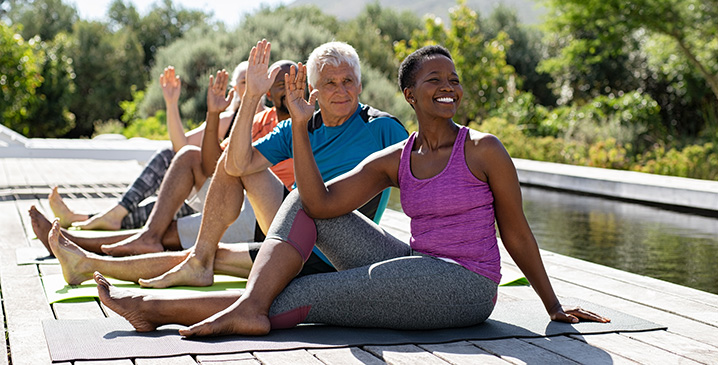If you suffer from arthritis, and your symptoms are flaring up, moving your body can seem all but impossible. Although it may seem counter-intuitive, there are many reasons why getting your joints moving is exactly what you want to do. First, physical activity improves the circulation of nourishing blood flow to the joints as well as synovial fluid, the joint lubricant that keeps things moving with minimal friction. Exercise also strengthens joints’ supportive structures— the muscles, ligaments, and tendons that act like scaffolding to support your shoulders, knees, ankles, hips, etc.
Stretching, which also greatly improves range of motion and flexibility, is a must no matter what your form of exercise is. The best stretches will depend on which of your joints are arthritic as well as your symptoms. As always, consult with a healthcare professional before commencing a new exercise regimen.
Here are a few general guidelines to keep in mind when you stretch.
- Warm up your muscles before stretching. Indulge in a warm bath or shower, take a short walk, or just get your limbs moving with arm circles, side bends, and other gentle movements. Increasing the temperature of the muscles’ collagen fibers — an important component of the muscles— makes them more elastic and responsive to stretching.
- Focus on dynamic, not static, stretching. Static stretching is when you stretch and hold the position for a period of time. Instead, do dynamic stretches which mimic the movements used in a sport or activity. For example, cat-cow stretches, when you’re on all fours alternating between arching and rounding your back, help prepare you for a range of everyday activities. Ankle circles can help stretch your ankle joints and prepare you for walking or hiking.
- Props like pillows, rolled up towels, foam rollers, and yoga straps, can be your friend. Pillows and rolled up towels or foam rollers like the one here, can provide extra support to joints while a yoga strap can help you maintain proper form.
- Figure out the best time of day to stretch based on your symptoms. For those who wake up in extreme distress, it might be wise to wait to stretch until your joints are less achy and stiff, although some physical therapists think that morning stretches are the best remedy for this. Let your body dictate timing.
While a physical therapist can provide you with a customized routine, here are some of the types of stretches commonly prescribed.
Neck: These stretches can be done standing or seated.
Shoulders: This video demonstrates both stretching and strengthening exercises for the shoulder. The stretching exercises begin at 6:14.
Hands: Some simple hand stretches.
Hips: This video provides a 15-minute series of hip stretches.
Knees: These stretches can help keep your knee moving and the cartilage healthy. Be sure to check out the videos that illustrate each stretch.
Ankles: The same team that brought you the hip stretch video offers this video for the toes, feet, and ankles.
Remember, stretching may cause some discomfort, but you shouldn’t experience pain. Listen to your body and don’t overdo it.
If you’d like to discuss exercise and other treatments for your joint pain, use our Find a Doctor tool to locate an expert in your area.







